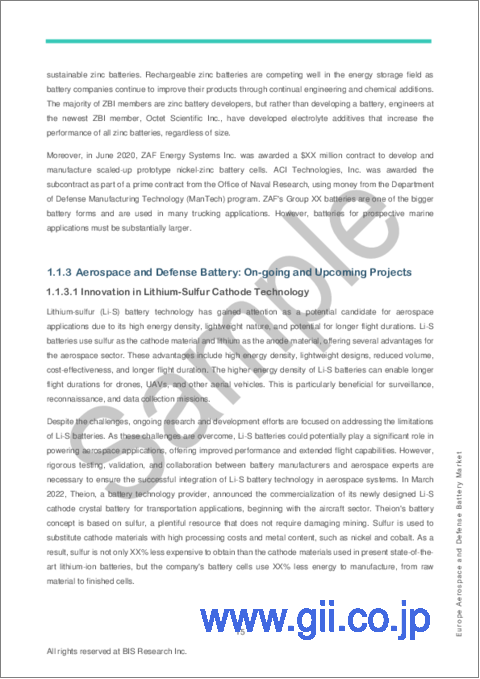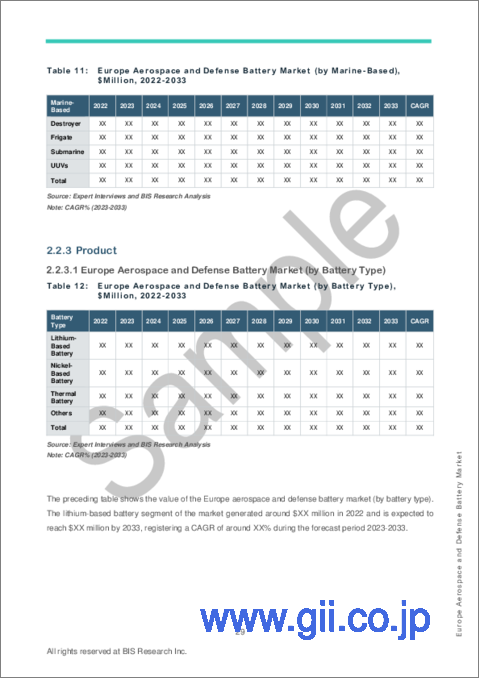|
|
市場調査レポート
商品コード
1399757
欧州の航空宇宙・防衛用電池市場: 分析と予測(2023年~2033年)Europe Aerospace and Defense Battery Market - Analysis and Forecast, 2023-2033 |
||||||
カスタマイズ可能
|
|||||||
| 欧州の航空宇宙・防衛用電池市場: 分析と予測(2023年~2033年) |
|
出版日: 2023年12月28日
発行: BIS Research
ページ情報: 英文 95 Pages
納期: 1~5営業日
|
全表示
- 概要
- 図表
- 目次
欧州の航空宇宙・防衛用電池の市場規模は、2023年~2033年に8.14%のCAGRで拡大し、2022年の23億米ドルから2033年には53億8,000万米ドルに達すると予測されています。
技術の飛躍的進歩や宇宙、航空機、UAV、防衛分野における電池の新たな用途の出現により、世界の航空宇宙・防衛用電池市場は近年著しい拡大を見せています。この増加は主に、これらの産業の電化を強化するための政府のイニシアチブによるもので、着実な拡大と著しい成長を示しています。さらに、eコマース企業やビデオ撮影、遠隔監視などの民間専門家による商用UAVの利用が増加していることも市場を牽引しています。当局は、UAVやバッテリー駆動ドローンを軍事監視サブシステムに組み込むことで、セキュリティ、信頼性、運用効率を向上させることができます。
| 主要市場統計 | |
|---|---|
| 予測期間 | 2023年~2033年 |
| 2023年評価 | 24億6,000万米ドル |
| 2033年予測 | 53億8,000万米ドル |
| CAGR | 8.14% |
欧州の航空宇宙・防衛用電池市場は大幅な成長を遂げており、近年は競合シェアを獲得する見込みです。この市場は主に、航空宇宙・防衛用途の厳しい要件を満たす電池とエネルギー貯蔵ソリューションの製造と供給に焦点を当てています。これらの電池は、航空機、宇宙船、軍用車両、UAV、潜水艦、防衛・航空宇宙業務で使用される電子機器など、さまざまな機器やシステムに応用されています。業界の電気およびハイブリッド電気推進システムへのシフトは、電気航空機の航続距離と効率を改善するために、より高いエネルギー密度を持つバッテリーの需要を促進しています。さらに、安全性を損なうことなく過酷な条件にも耐えられるバッテリーシステムの開発も重視されています。地域政府も、航空宇宙分野における温度や高度に関連する懸念に対応し、先進的なバッテリー技術を革新・開発するため、地元メーカーや研究機関を支援しています。これらの要因が、予測期間中の欧州の航空宇宙・防衛用電池市場の拡大に寄与すると予想されます。
当レポートでは、欧州の航空宇宙・防衛用電池市場について調査し、市場の概要とともに、用途別、電池タイプ別、国別の動向、および市場に参入する企業のプロファイルなどを提供しています。
目次
エグゼクティブサマリー
調査範囲
第1章 市場
- 業界の展望
- ビジネスダイナミクス
第2章 欧州
- 航空宇宙・防衛用電池市場(地域別)
- 欧州
- 市場
- 応用
- 製品
- 欧州(国別)
第3章 市場-競合ベンチマーキングと企業プロファイル
- 競合ベンチマーキング
- 企業プロファイル
- Lincad
- WAE Technologies Limited
- その他の主要選手プロファイル
第4章 調査手法
List of Figures
- Figure 1: Aerospace and Defense Battery Market, $Billion, 2022-2033
- Figure 2: Aerospace and Defense Battery Market (by Platform), $Billion, 2023 and 2033
- Figure 3: Aerospace and Defense Battery Market (by Battery Type), $Billion, 2023 and 2033
- Figure 4: Aerospace and Defense Battery Market (by Lithium-Based Battery), $Billion, 2023 and 2033
- Figure 5: Aerospace and Defense Battery Market (by Nickel-Based Battery), $Billion, 2023 and 2033
- Figure 6: Aerospace and Defense Battery Market (by Region), $Billion, 2033
- Figure 7: Supply Chain Analysis for Aerospace and Defense Battery Market
- Figure 8: Aerospace and Defense Battery Market, Business Dynamics
- Figure 9: Share of Key Business Strategies and Developments, January 2020-August 2023
- Figure 10: Aerospace and Defense Battery Market, Competitive Benchmarking
- Figure 11: Research Methodology
- Figure 12: Top-Down and Bottom-Up Approach
- Figure 13: Assumptions and Limitations
List of Tables
- Table 1: Funding and Investment Scenario, January 2021-August 2023
- Table 2: Comparative Landscape (by Application)
- Table 3: Patent Landscape
- Table 4: New Product Launches, Developments, and Others, January 2020-August 2023
- Table 5: Partnerships, Collaborations, Agreements, Contracts, and Others, January 2020-August 2023
- Table 6: Aerospace and Defense Battery Market (by Region), $Million, 2022-2033
- Table 7: Europe Aerospace and Defense Battery Market (by Platform), $Million, 2022-2033
- Table 8: Europe Aerospace and Defense Battery Market (by Space), $Million, 2022-2033
- Table 9: Europe Aerospace and Defense Battery Market (by Aircraft), $Million, 2022-2033
- Table 10: Europe Aerospace and Defense Battery Market (by UAV), $Million, 2022-2033
- Table 11: Europe Aerospace and Defense Battery Market (by Defense), $Million, 2022-2033
- Table 12: Europe Aerospace and Defense Battery Market (by Ground-Based), $Million, 2022-2033
- Table 13: Europe Aerospace and Defense Battery Market (by Marine-Based), $Million, 2022-2033
- Table 14: Europe Aerospace and Defense Battery Market (by Battery Type), $Million, 2022-2033
- Table 15: Europe Aerospace and Defense Battery Market (by Lithium-Based Battery Type), $Million, 2022-2033
- Table 16: Europe Aerospace and Defense Battery Market (by Nickel-Based Battery Type), $Million, 2022-2033
- Table 17: France Aerospace and Defense Battery Market (by Battery Type), $Million, 2022-2033
- Table 18: France Aerospace and Defense Battery Market (by Lithium-Based Battery Type), $Million, 2022-2033
- Table 19: France Aerospace and Defense Battery Market (by Nickel-Based Battery Type), $Million, 2022-2033
- Table 20: Germany Aerospace and Defense Battery Market (by Battery Type), $Million, 2022-2033
- Table 21: Germany Aerospace and Defense Battery Market (by Lithium-Based Battery Type), $Million, 2022-2033
- Table 22: Germany Aerospace and Defense Battery Market (by Nickel-Based Battery Type), $Million, 2022-2033
- Table 23: U.K. Aerospace and Defense Battery Market (by Battery Type), $Million, 2022-2033
- Table 24: U.K. Aerospace and Defense Battery Market (by Lithium-Based Battery Type), $Million, 2022-2033
- Table 25: U.K. Aerospace and Defense Battery Market (by Nickel-Based Battery Type), $Million, 2022-2033
- Table 26: Rest-of-Europe Aerospace and Defense Battery Market (by Battery Type), $Million, 2022-2033
- Table 27: Rest-of-Europe Aerospace and Defense Battery Market (by Lithium-Based Battery Type), $Million, 2022-2033
- Table 28: Rest-of-Europe Aerospace and Defense Battery Market (by Nickel-Based Battery Type), $Million, 2022-2033
- Table 29: Benchmarking and Weightage Parameters
- Table 30: Lincad: Product Portfolio
- Table 31: Lincad: Product Developments and Fundings
- Table 32: Lincad: Partnerships, Collaborations, Contracts, and Agreements
- Table 33: WAE Technologies Limited: Product Portfolio
- Table 34: WAE Technologies Limited: Partnerships, Collaborations, Contracts, and Agreements
- Table 35: Other Key Player Profiles
Introduction to Europe Aerospace and Defense Battery Market
The Europe aerospace and defense battery market is estimated to reach $5.38 billion by 2033 from $2.30 billion in 2022, at a CAGR of 8.14% during the forecast period 2023-2033. Due to technological breakthroughs and the advent of new applications of batteries in space, aircraft, UAVs, and the defense sector, the worldwide aerospace and defense battery market has undergone significant expansion in recent years. This increase is primarily driven by the government's initiatives to enhance electrification of these industries, which have shown steady expansion and significant growth. Furthermore, the market is being driven by the increasing use of commercial UAVs by e-commerce firms and other civil professionals such as videography, remote monitoring, and so on. Authorities can improve security, reliability, and operational efficiency by incorporating UAVs and battery-powered drones into military surveillance subsystems.
Market Introduction
| KEY MARKET STATISTICS | |
|---|---|
| Forecast Period | 2023 - 2033 |
| 2023 Evaluation | $2.46 Billion |
| 2033 Forecast | $5.38 Billion |
| CAGR | 8.14% |
The European aerospace and defense battery market is witnessing substantial growth and is expected to gain a competitive share in recent years. This market primarily focuses on the manufacturing and supply of batteries and energy storage solutions that meet the stringent requirements of aerospace and defense applications. These batteries find applications in various equipment and systems, including aircraft, spacecraft, military vehicles, UAVs, submarines, and electronic devices used in defense and aerospace operations. The industry's shift towards electric and hybrid-electric propulsion systems is driving the demand for batteries with higher energy densities for improved range and efficiency in electric aircraft. Additionally, there is a strong emphasis on developing battery systems capable of withstanding extreme conditions without compromising safety. Regional governments are also supporting local manufacturers and research institutes to innovate and develop advanced battery technology, catering to temperature and altitude-related concerns in the aerospace sector. These factors are expected to contribute to the expansion of the European aerospace and defense battery market during the forecast period.
Market Segmentation:
Segmentation 1: by Application (Platform)
- Space
- Satellite
- Launch Vehicle
- Deep Space
- Aircraft
- Military
- Civil and Commercial
- UAV
- Military
- Civil and Commercial
- Defense
- Ground Based
- Marine Based
Segmentation 2: by Battery Type
- Lithium-Based Battery
- Lithium Polymer Battery
- Lithium-Ion Battery
- Nickel-Based Battery
- Nickel-Cadmium (NiCd) Battery
- Nickel-Metal Hydride Battery
- Thermal Battery
- Others
Segmentation 3: by Country
- U.K.
- France
- Germany
- Rest-of-Europe
How can this report add value to an organization?
Product/Innovation Strategy: The product segment helps the reader understand the different types of batteries available for deployment and their potential in Europe region. Moreover, the study provides the reader with a detailed understanding of the aerospace and defense battery market.
Growth/Marketing Strategy: The Europe aerospace and defense battery market has seen major developments by key players operating in the market, such as contracts, collaborations, and joint ventures. The favored strategy for the companies has been contracted to strengthen their position in the market.
Methodology: The research methodology design adopted for this specific study includes a mix of data collected from primary and secondary data sources. Both primary resources (key players, market leaders, and in-house experts) and secondary research (a host of paid and unpaid databases), along with analytical tools, are employed to build the predictive and forecast models.
Table of Contents
Executive Summary
Scope of the Study
1. Market
- 1.1. Industry Outlook
- 1.1.1. Market Overview: Aerospace and Defense Battery Market
- 1.1.2. Current and Emerging Technological Trends
- 1.1.2.1. Lithium Titanate Oxide (LTO) Batteries
- 1.1.2.2. Conformable Wearable Batteries (CWBs)
- 1.1.2.3. Solid-State Battery Technologies
- 1.1.2.4. Nickle-Zinc Batteries for Aerospace and Defense
- 1.1.3. Aerospace and Defense Battery: On-going and Upcoming Projects
- 1.1.3.1. Innovation in Lithium-Sulfur Cathode Technology
- 1.1.3.2. Defense Advanced Research Agency (DARPA)'s Morphogenic Interfaces (MINT) Program
- 1.1.3.3. Lithium-Ion Polymer Rechargeable Battery
- 1.1.3.4. Sodium-Sulfur (NAS) Battery to Misasa Deep Space Station (MDSS)
- 1.1.3.5. Space Battery Powered by Americium-241
- 1.1.4. Start-up and Investment Landscape
- 1.1.5. Comparative Analysis
- 1.1.6. Patent Analysis
- 1.1.7. Supply Chain Analysis
- 1.2. Business Dynamics
- 1.2.1. Business Drivers
- 1.2.1.1. Growing Penetration of Unmanned Aerial Vehicles (UAVs) and Electric Ground Vehicles in Defense Sector
- 1.2.1.2. Increasing Electrification of Aircraft
- 1.2.1.3. Rising Investment Activities to Support Deep Space Exploration
- 1.2.2. Business Challenges
- 1.2.2.1. Stringent Regulation Impacting the Sales of Lithium Batteries
- 1.2.2.2. Design Challenges Associated with the Size of Aircraft
- 1.2.3. Business Strategies
- 1.2.3.1. New Product Launches, Developments, and Others
- 1.2.4. Corporate Strategies
- 1.2.4.1. Partnerships, Collaborations, Agreements, Contracts, and Others
- 1.2.5. Business Opportunities
- 1.2.5.1. Growing Advancements in Battery Cell Materials for Long Endurance
- 1.2.5.2. Emergence of Urban Air Mobility and eVTOL Vehicles
- 1.2.5.3. Adoption of Miniaturized Electronic Devices and Wearable Technologies in Military
- 1.2.5.4. Rising Integration of Space-Grade Batteries for Satellite Launch Missions
- 1.2.1. Business Drivers
2. Europe
- 2.1. Aerospace and Defense Battery Market (by Region)
- 2.2. Europe
- 2.2.1. Market
- 2.2.1.1. Key Manufacturers and Suppliers in Europe
- 2.2.1.2. Business Drivers
- 2.2.1.3. Business Challenges
- 2.2.2. Application
- 2.2.2.1. Europe Aerospace and Defense Battery Market (by Platform)
- 2.2.3. Product
- 2.2.3.1. Europe Aerospace and Defense Battery Market (by Battery Type)
- 2.2.4. Europe (by Country)
- 2.2.4.1. France
- 2.2.4.1.1. Market
- 2.2.4.1.1.1. Key Manufacturers and Suppliers in France
- 2.2.4.1.2. Product
- 2.2.4.1.2.1. France Aerospace and Defense Battery Market (by Battery Type), Value
- 2.2.4.1.1. Market
- 2.2.4.2. Germany
- 2.2.4.2.1. Market
- 2.2.4.2.1.1. Key Manufacturers and Suppliers in Germany
- 2.2.4.2.2. Product
- 2.2.4.2.2.1. Germany Aerospace and Defense Battery Market (by Battery Type), Value
- 2.2.4.2.1. Market
- 2.2.4.3. U.K.
- 2.2.4.3.1. Market
- 2.2.4.3.1.1. Key Manufacturers and Suppliers in the U.K.
- 2.2.4.3.2. Procuct
- 2.2.4.3.2.1. U.K. Aerospace and Defense Battery Market (by Battery Type), Value
- 2.2.4.3.1. Market
- 2.2.4.4. Rest-of-Europe
- 2.2.4.4.1. Market
- 2.2.4.4.1.1. Key Manufacturers and Suppliers in Rest-of-Europe
- 2.2.4.4.2. Product
- 2.2.4.4.2.1. Rest-of-Europe Aerospace and Defense Battery Market (by Battery Type), Value
- 2.2.4.4.1. Market
- 2.2.4.1. France
- 2.2.1. Market
3. Market - Competitive Benchmarking & Company Profiles
- 3.1. Competitive Benchmarking
- 3.2. Company Profiles
- 3.2.1. Lincad
- 3.2.1.1. Company Overview
- 3.2.1.1.1. Role of Lincad in the Aerospace and Defense Battery Market
- 3.2.1.1.2. Product Portfolio
- 3.2.1.2. Business Strategies
- 3.2.1.2.1. Product Developments and Fundings
- 3.2.1.3. Corporate Strategies
- 3.2.1.3.1. Partnerships, Collaborations, Contracts, and Agreements
- 3.2.1.4. Analyst View
- 3.2.1.1. Company Overview
- 3.2.2. WAE Technologies Limited
- 3.2.2.1. Company Overview
- 3.2.2.1.1. Role of WAE Technologies Limited in the Aerospace and Defense Battery Market
- 3.2.2.1.2. Product Portfolio
- 3.2.2.2. Corporate Strategies
- 3.2.2.2.1. Partnerships, Collaborations, Contracts, and Agreements
- 3.2.2.3. Analyst View
- 3.2.2.1. Company Overview
- 3.2.1. Lincad
- 3.3. Other Key Player Profiles
4. Research Methodology
- 4.1. Factors for Data Prediction and Modeling





